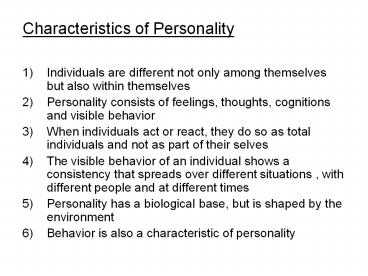Characteristics of Personality - PowerPoint PPT Presentation
Title:
Characteristics of Personality
Description:
Characteristics of Personality ... Theories of personality Other Personality Traits relevant to OB Linking an individual s Personality & values to the ... – PowerPoint PPT presentation
Number of Views:347
Avg rating:3.0/5.0
Title: Characteristics of Personality
1
Characteristics of Personality
- Individuals are different not only among
themselves but also within themselves - Personality consists of feelings, thoughts,
cognitions and visible behavior - When individuals act or react, they do so as
total individuals and not as part of their selves - The visible behavior of an individual shows a
consistency that spreads over different
situations , with different people and at
different times - Personality has a biological base, but is shaped
by the environment - Behavior is also a characteristic of personality
2
Measuring Personality
- Ways in which Personality is measured
- Self Report Surveys
- Observer Rating Survey
- Projective Measures
3
Uses of Assessments in Organizations
- Screening
- Selection
- Succession Planning
- Career Planning
- Team Building
- Management Development
- Personality Determinants
4
Myers Briggs type indicator
- (E or I) Extravert vs Introvert
- (S or N) Sensing vs Intuitive
- (T or F) Thinking vs Feeling
- (J or P) Judging or Perceiving
5
Big Five Personality Model
- 5 Factor Model called Big 5
- 5 Basic dimensions underlie all other
- Extraversion
- Agreeableness
- Conscientiousness
- Emotional Stability
- Openness to Experience
6
16 P Factor Questionnaire Based on 16 souce
traits
- Johari Window
The Johari Window is a communication model that
can be used to improve understanding between
individuals. Developed by Joseph Luft and Harry
Ingham (the word Johari comes from Joseph Luft
and Harry Ingham).
7
- The Johari Window is a communication model that
can be used to improve understanding between
individuals. - Developed by Joseph Luft and Harry Ingham (the
word Johari comes from Joseph Luft and Harry
Ingham).
8
Two key ideas behind the tool
- Individuals can build trust between themselves by
disclosing information about themselves. - They can learn about themselves and come to terms
with personal issues with the help of feedback
from others.
9
- Using the Johari model, each person is
represented by their own four-quadrant, or
four-pane, window. Each of these contains and
represents personal information - feelings,
motivation - about the person, and shows whether
the information is known or not known by
themselves or other people.
10
Johari Window
Feedback
Known to self
Unknown to Self
Known to others
Arena
Blind Spot
Exposure
Facade
Unknown
Unknown to Others
11
- Behavior/ Activities cause panes to move or
change size. - Arena- Giving soliciting feedback. Self
disclosure - Blind spot- Soliciting being receptive to
feedback - Facade-Giving feedback and self disclosure
- Unknown- Availing yourself and being receptive
to sharing experiences of others learning
vicariously
12
Feedback
- Communicate to a person or group providing
information as to how their behavior is affecting
or influencing you. (giving feedback) - It may also be a reaction by others as to how
your behavior is affecting or influencing them
(receiving feedback)
13
Reasons for giving receiving feedback
- Allows personal growth
- Enables the provider to learn about self
- Enables the receiver to gain insight
- Creates an open environment for effective
operation and interpersonal communication - Aids in preparation for the future not dwelling
on the past
14
Theories of personality
- 1)Trait Theory Eysenck (1960)
- 2) Psychoanalytic Theory Sigmund Freud
- 3) Behaviorism Theory
- 4) Humanistic Theory
- 5) Physique Temperament Theory Sheldon (1942)
15
Other Personality Traits relevant to OB
- Core Self-evaluation
- Machiavellianism
- Narcissism
- Self Monitoring
- Risk taking
- Type A personality
- 7) Proactive Personality 8) High
Flyers
16
Linking an individuals Personality values to
the Workplace
- Person-Job fit
- Person Organization fit































